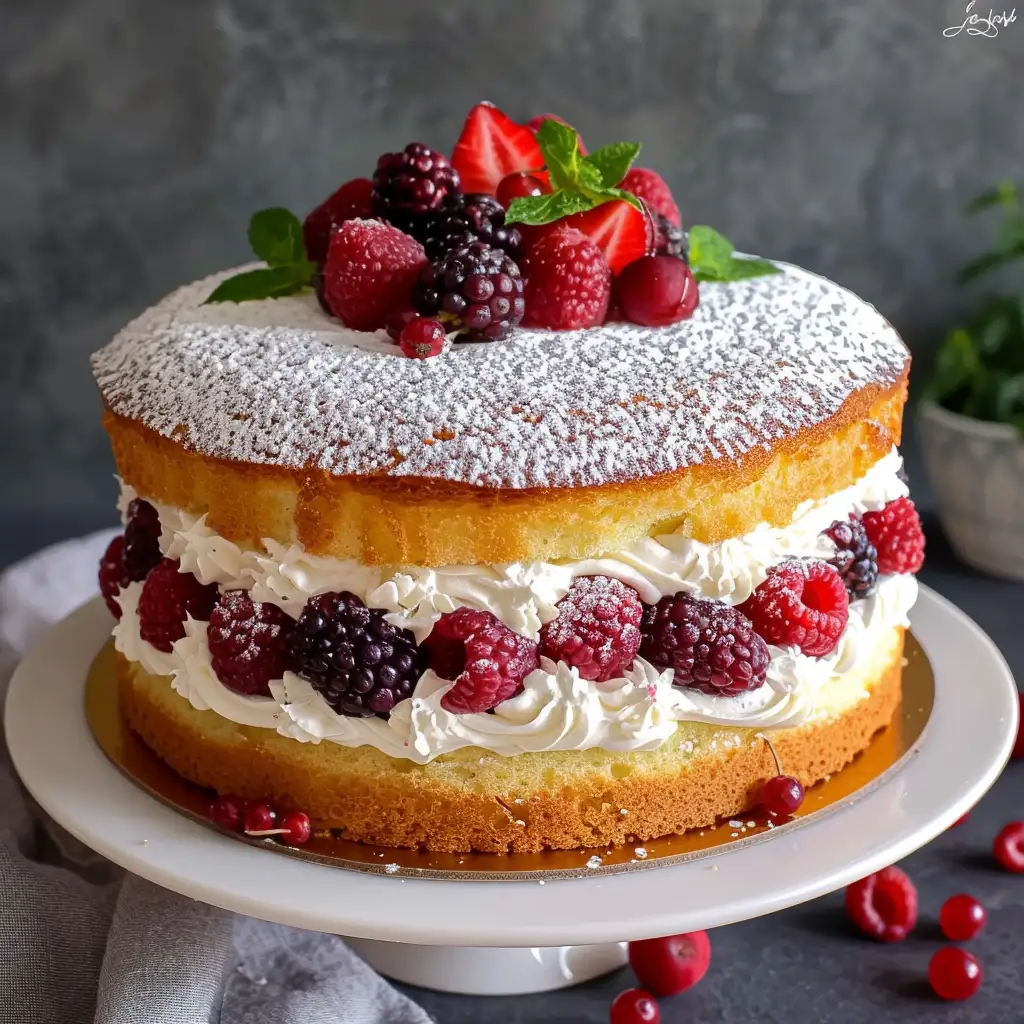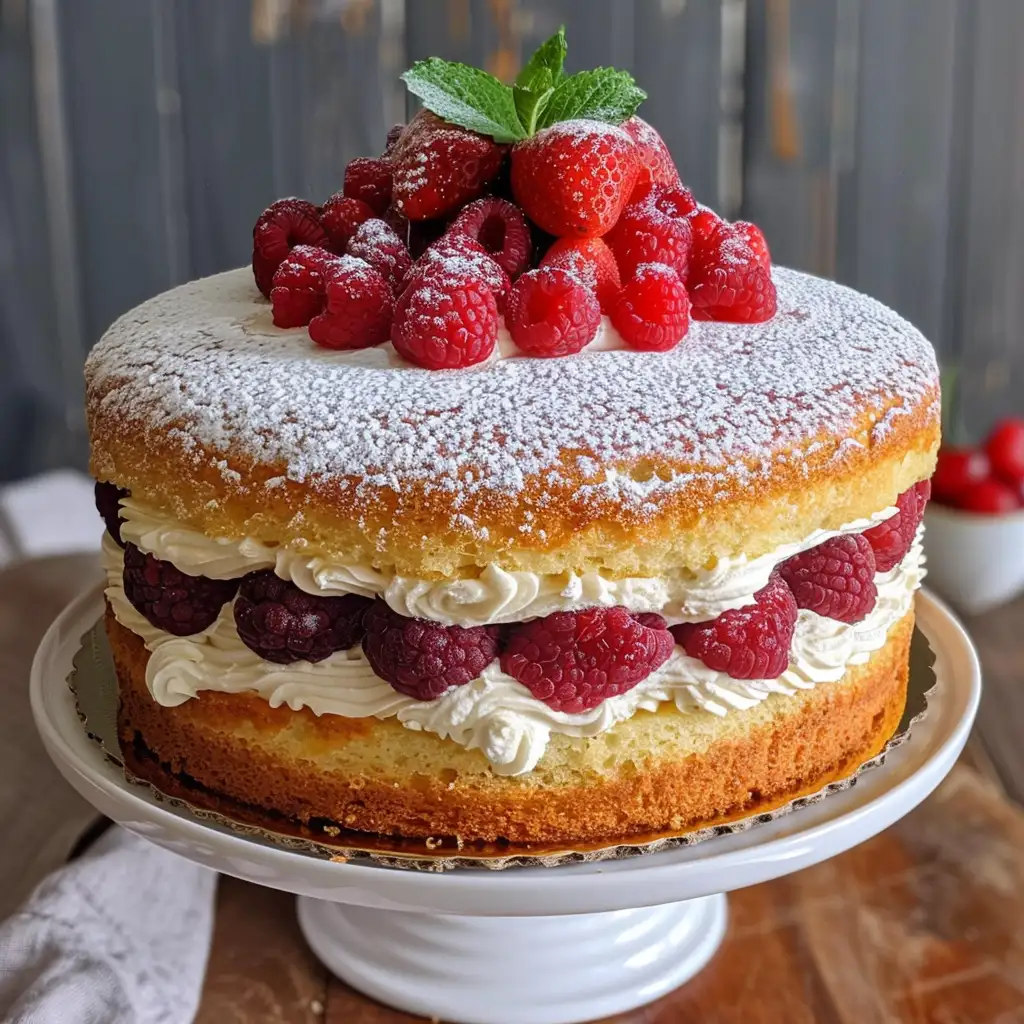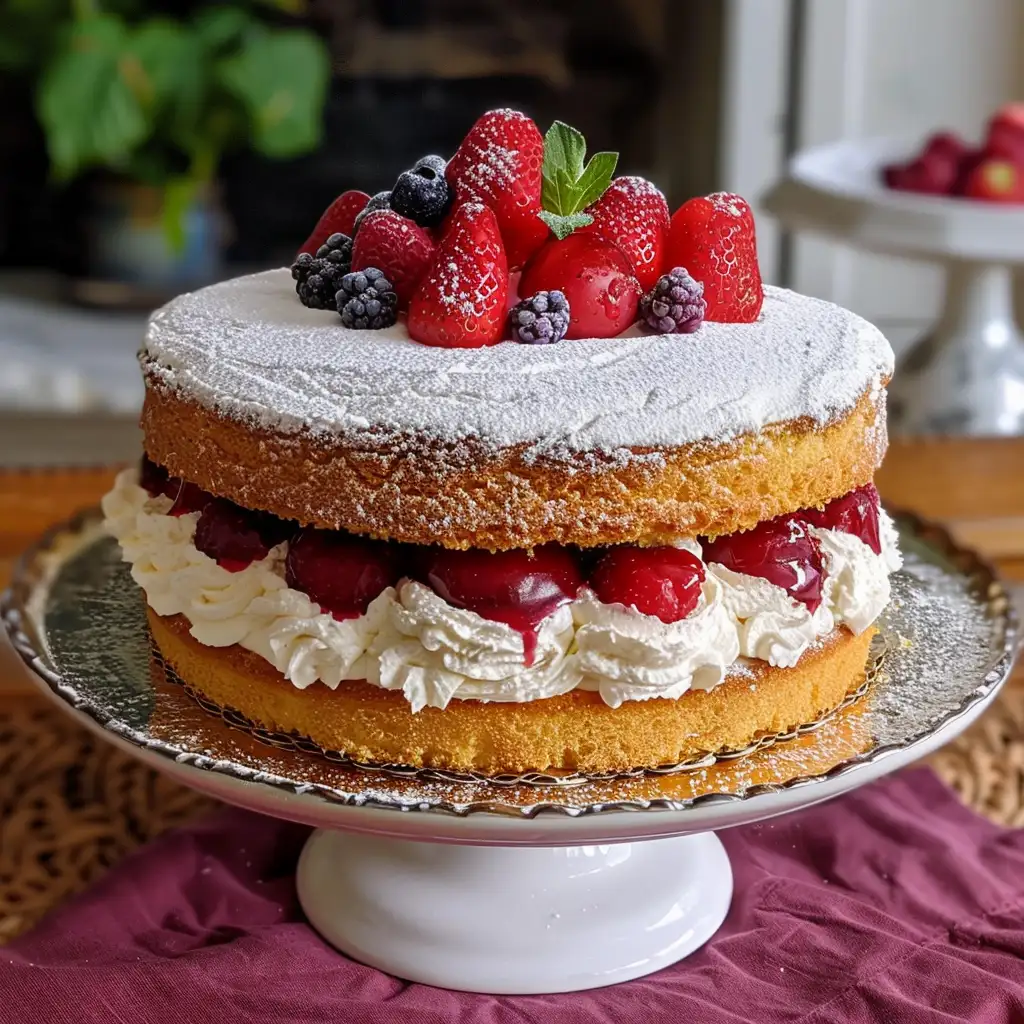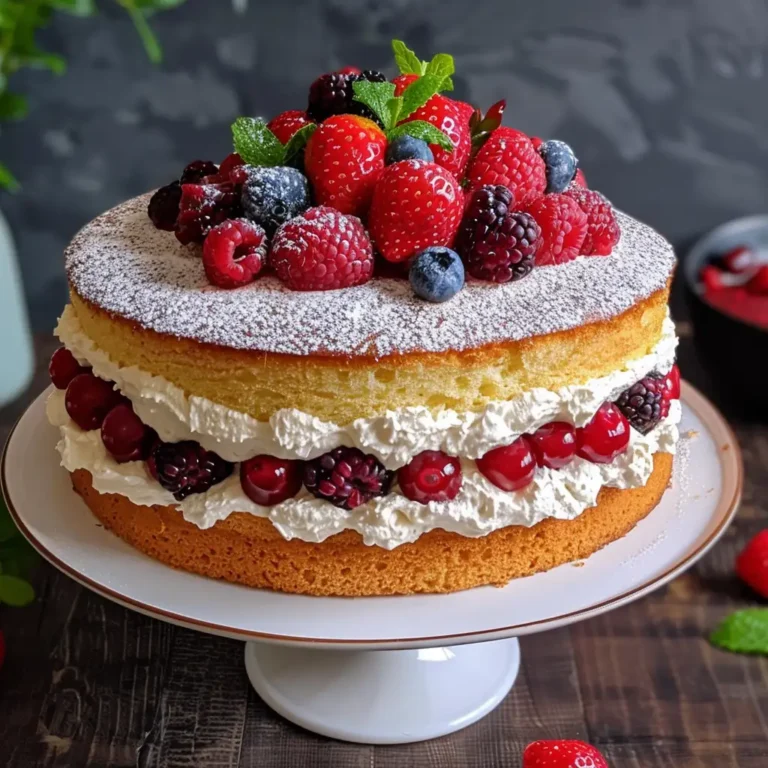Victoria Sponge Cake: A Quintessential British Delight
Introduction
The Victoria Sponge Cake, named after Queen Victoria, who was known to enjoy a slice with her afternoon tea, is a quintessential part of British culinary tradition. This classic cake is celebrated for its delightful simplicity and superb balance of flavors. Typically made with butter, sugar, eggs, and flour, the Victoria Sponge is famous for its airy, moist texture and jam-filled center topped with a dusting of sugar.
The cake not only embodies the essence of British tea-time but also holds a place at modern celebrations and gatherings, reflecting its enduring appeal. The simplicity of its ingredients—highlighted by the creamy texture of the jam and the soft richness of the whipped cream—makes the Victoria Sponge a perennial favorite.

Recipe Ingredients
The Victoria Sponge Cake calls for straightforward, wholesome ingredients:
- 200g of caster sugar
- 200g of softened butter, plus extra for greasing
- 4 large eggs, beaten
- 200g of self-raising flour, sifted
- 1 teaspoon of baking powder
- 2 tablespoons of milk
For the filling:
- 100g of softened butter
- 140g of sifted icing sugar
- Half a jar (about 170g) of high-quality strawberry jam
- A drop of vanilla extract (optional)
Optional Variations
For those with specific dietary needs, here are some substitutions:
- Gluten-Free: Substitute the self-raising flour with a gluten-free blend and 1 extra tsp of baking powder.
- Vegan: Use plant-based butter and a suitable egg replacer.
Step-by-Step Baking Instructions
Preparing the Baking Tins
- Preheat your oven to 190°C (fan 170°C, gas mark 5).
- Grease two 20cm cake tins with butter and line them with non-stick baking paper.
Making the Batter
- In a large mixing bowl, cream together 200g of caster sugar and 200g of softened butter until pale and fluffy.
- Gradually add 4 beaten eggs, mixing thoroughly after each addition.
- Fold in 200g of self-raising flour and 1 tsp of baking powder, then stir in 2 tbsp of milk to create a smooth, soft batter.
Baking
- Divide the mixture evenly between the prepared tins, smoothing the top with a spatula.
- Bake in the preheated oven for about 20 minutes, or until golden and a skewer inserted into the center comes out clean.
- Allow the cakes to cool in the tins for 5 minutes, then turn out onto a wire rack to cool completely.
Assembling the Cake
- For the filling, beat 100g of softened butter with 140g of icing sugar and a drop of vanilla extract until smooth.
- Spread the buttercream over the bottom layer of the cake, then top with a generous layer of strawberry jam.
- Place the second cake layer on top and gently press down.
- Dust with icing sugar before serving.
Visual cues for a perfect cake include a golden-brown color and a springy texture that rebounds when lightly pressed. This method will ensure your Victoria Sponge is both visually appealing and delicious.
Explore more traditional British recipes like these classic cheese scones, perfect for complementing your tea-time spread.
Find healthy packed lunch inspirations to go with your sponge cake, featuring recipes that are both nutritious and delicious.
Conclusion
Mastering the Victoria Sponge Cake is a rite of passage for any baker worth their salt. Its simplicity, elegance, and delightful taste make it a staple for any occasion, from a quiet afternoon tea to a celebratory gathering. Dive into this baking adventure and enjoy one of Britain’s most beloved cakes, sure to win over hearts and palates with its sublime flavor and perfect texture.

Filling Preparation
Creating the perfect filling for a Victoria Sponge Cake enhances both its flavor and texture. Here are the steps and variations for making the traditional buttercream and jam filling:
Traditional Buttercream and Jam Filling
- Buttercream:
- Beat 100g of softened butter until creamy.
- Gradually add 140g of sifted icing sugar and mix until smooth.
- Incorporate a drop of vanilla extract for extra flavor (optional).
- Jam:
- Use approximately 170g of high-quality strawberry jam.
- For a smoother consistency, stir the jam before spreading on the cake.
Variations of Fillings
- Fresh Cream: Whip double cream with a tablespoon of sugar until stiff peaks form, then spread over the bottom cake layer.
- Lemon Curd: Spread lemon curd over the buttercream for a tangy twist.
- Chocolate Ganache: Melt chocolate with cream and cool slightly before spreading between the sponge layers.
Explore innovative filling ideas and perfect your buttercream technique with Nigella’s take on the Victoria Sponge for more variety.
Assembly Tips
Assembling your Victoria Sponge Cake correctly is crucial for both appearance and ease of serving. Here are some tips to help you layer your cake neatly:
- Bottom Layer:
- Place the first cake layer on a plate or cake stand.
- Spread the buttercream evenly, leaving a slight edge around the perimeter to prevent overflow.
- Adding Jam:
- Gently spread the jam over the buttercream, or on the second layer for easier assembly.
- Top Layer:
- Carefully align and place the second sponge on top.
- Press down lightly to secure the fillings.
Presentation Tips
- Ensure the top of the cake is flat by trimming any dome-shaped tops before assembly.
- Dust with icing sugar through a sieve for a professional finish.
- Decorate with fresh berries or edible flowers for an elegant touch.
Serving and Storage
To serve and store your Victoria Sponge Cake properly:
Serving Tips
- Slice with a serrated knife, using a gentle sawing motion.
- Serve at room temperature to best enjoy the flavors.
Storage Tips
- Store in an airtight container.
- Keep at room temperature for up to 2 days.
- Refrigerate if filled with fresh cream, but allow to come to room temperature before serving.
Find healthy packed lunch inspirations to go with your sponge cake, featuring recipes that are both nutritious and delicious.
Common Mistakes to Avoid
Avoid these common baking and assembly errors to ensure your Victoria Sponge Cake turns out perfectly:
Baking Mistakes
- Uneven Rise: Ensure even mixing of batter and check your oven temperature.
- Dry Texture: Do not over-bake; check the cake regularly near the end of baking time.
Moisture and Fluffiness Tips
- Ingredient Temperatures: Use room temperature ingredients for a more uniform texture.
- Mixing Technique: Fold flour gently into the mixture to retain air and lightness.
Prevent common issues and achieve perfect results every time with these tried and tested tips. Remember, a successful Victoria Sponge relies as much on technique as on the quality of ingredients.

FAQs About Victoria Sponge Cake
What makes a Victoria Sponge Cake unique compared to other sponge cakes?
The Victoria Sponge Cake stands out due to its traditional sandwich structure, typically filled with strawberry jam and buttercream. Unlike other sponge cakes that might incorporate oils or leavening agents like baking soda, the Victoria Sponge relies solely on the air whipped into eggs to rise. This method gives it a particularly light and airy texture that is both delicate and rich in flavor.
Can I substitute butter in the recipe for an oil-based alternative?
Yes, you can substitute butter for an oil-based alternative like canola oil or coconut oil to make the sponge cake. Using oil instead of butter will generally make the cake moister and denser, which some people prefer. However, keep in mind that this will slightly alter the traditional taste and texture of the Victoria Sponge Cake, potentially making it less authentic but still delicious.
- Use 180g of oil in place of 200g of butter as a general rule.
- Be aware that the cake might cook faster with oil, so keep a close eye on it.
For detailed substitution tips and techniques, explore Nigella’s take on the Victoria Sponge, where you can find various adaptations of the recipe.
How do I ensure the cake doesn’t collapse after baking?
To prevent your Victoria Sponge from collapsing:
- Even Mixing: Ensure that all ingredients are mixed evenly, without over-beating, which can introduce too much air into the batter.
- Oven Temperature: Preheat your oven and bake at the correct temperature. A too-hot oven can cause the cake to rise and then fall.
- Do Not Open the Oven: Keep the oven door closed while the cake is baking to prevent drafts from causing the cake to fall.
What are the best jams for the filling?
The choice of jam can greatly enhance the overall flavor of your Victoria Sponge Cake. Traditional choices include:
- Strawberry jam, for its classic flavor and bright sweetness.
- Raspberry jam, which offers a slight tartness that complements the sweet cake and cream.
- Apricot jam, for a milder, slightly tangy filling.
Select high-quality or homemade jams for the best flavor profile in your cake.
Can the cake be made in advance?
Yes, the Victoria Sponge Cake can be made in advance, making it perfect for gatherings and events:
- Bake the sponges a day ahead, and once cooled, wrap them tightly in cling film to keep them moist.
- Assemble the cake no more than a few hours before serving to prevent the jam and cream from making the sponge soggy.
For more tips on making the perfect dessert in advance, visit healthy packed lunch inspirations which also offer great advice on preserving freshness in baked goods.
These FAQs cover essential tips and tricks for mastering the Victoria Sponge Cake, ensuring delicious results every time. Whether adjusting ingredients for dietary preferences or ensuring the perfect rise, these insights will help you bake the perfect cake.

